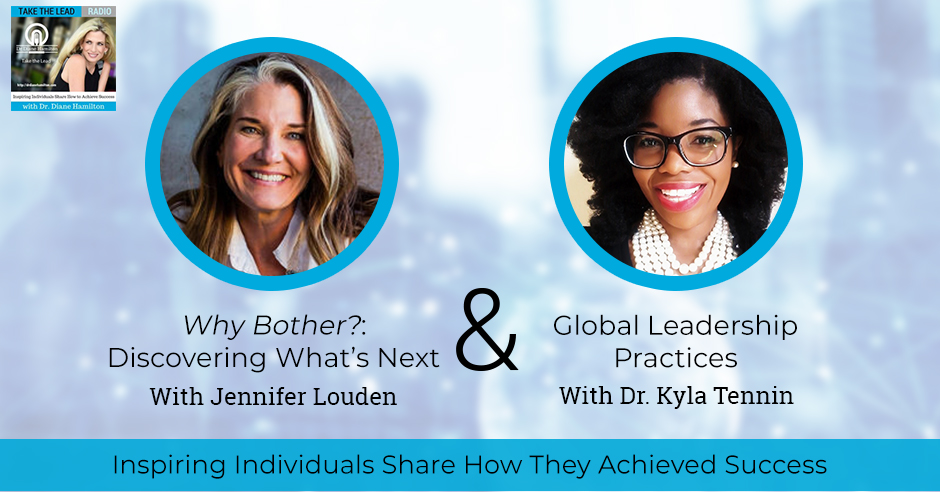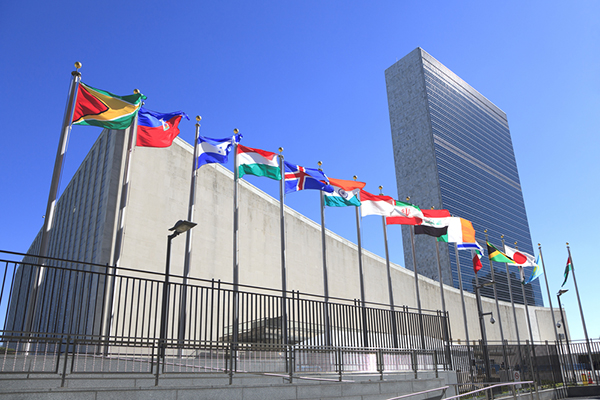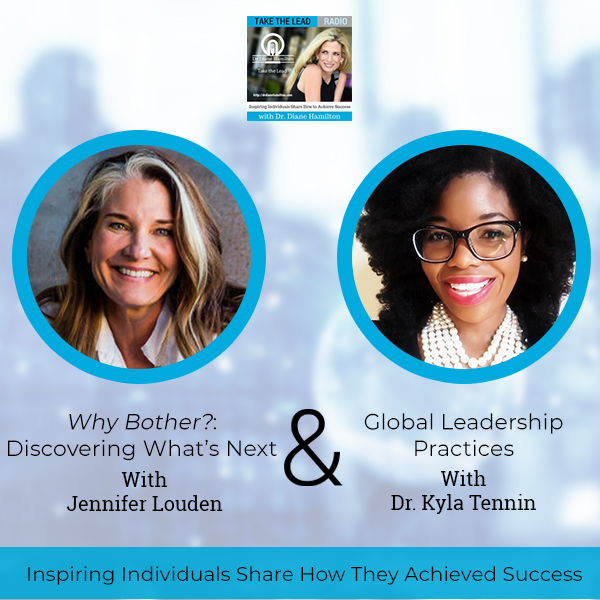We can get so easily lost with whatever is going on around us that we forget to ask the necessary questions for ourselves. Dr. Diane Hamilton talks with personal growth pioneer, Jennifer Louden, about finding answers to how we can engage most with our lives and be our fullest selves. Through her new book, Why Bother?, Jennifer brings us back to the things within ourselves that we’ve long been putting into the corner. She shares the ways we can tap into our deepest desires to discover what’s next. So start asking yourself, what do you want to bother about?
Aligned with the topic on what’s next, Diane also interviews Dr. Kyla Tennin—Chair of the Board, President, and Global CEO of Lady Mirage Global—about her journey to getting a higher education and becoming a global CEO. Offering insights for businesses that want to grow and expand, she shares with us her dissertation entitled, “Regional Executive Leadership Turnover in Multinational Corporations.” She gives out some global leadership practices that vary from different perspectives on leadership styles across the world. Gain a great deal of learning on leadership and more in this conversation.

I’m glad you joined us because we have Jennifer Louden and Dr. Kyla Tennin here. Jennifer has a brand new book. I’m excited, it’s called Why Bother? I’m sure you’ve seen her on Oprah and everywhere else. Dr. Kyla Tennin is the Chair of the Board of Directors, President, and Global CEO. She is an inventor, investor, a global board advisor and expert, a keynote speaker, author, you name it. We’ve got two powerful women here. I’m looking forward to it.
Watch the episode here
Listen to the podcast here
Why Bother?: Discovering What’s Next With Jennifer Louden
I am here with Jennifer Louden, who is a personal growth pioneer who helped launch the concept of self-care with her first bestseller, The Woman’s Comfort Book. Since then, she’s written an additional six books on well-being and whole living, including Women’s Retreat Book and The Life Organizer. Close to a million copies of her books are in print in nine languages. Her most recent book is Why Bother? I want to talk to her about that. She’s been everywhere. You’ve probably seen her everywhere, even Oprah. I’m excited to have you here, Jennifer. Welcome.
It’s my pleasure. It feels relevant to be talking about Why Bother? I’m delighted to be here.
It’s probably more relevant than ever. I can’t even imagine how many people want to talk to you. It’s a difficult time. A lot of people are wondering, “How are things going to change? How are things going to get better?” They’re asking themselves those questions. I know you deal with a lot of other issues prior to Why Bother? A lot of people asking you why bother with not just the climate crisis and things like that but this particular Coronavirus crisis.
What I see happening is in some ways what we care about and what we bother about is in our faces. We care about the people we love. My daughter works in mental health at Seattle Children’s Hospital and she’s been working at home but they’re calling them all back into the floor where she’ll be in contact with people who are sick. We know what we care about. We care about the people we love. We care about our neighbors. We care about our health, but in other ways, it’s calling into question, do I care about my job? What about this person I’m in a partnership with that I’m locked in my house with? It’s bringing up other questions that are scary for people. It’s a strong contrast that in some ways, we know exactly what we bother about but some of the bigger questions about work and bigger questions about our life after things return to normal are even scary.
It can be. It’s funny because I was talking to a friend of mine. Her husband is home now all the time. I was teasing her. I said, “Are you pregnant or getting divorced?” You don’t know what’s going to happen. It’s a whole another level of looking at what we want to do with our lives and what matters to us. I want to get a little background. I know we jumped in. In case people aren’t familiar with your work, what led to your interest in all these comfort help books?
I was always one of those people who wondered how people could have a better life or when I was younger, why people didn’t? I remember, as a kid, looking around at my parents and my parents’ friends and my parents were great, but wondering like, “Why aren’t people as alive as they can be?” It always perplexed me as a kid when people seem to bag out on life, whether they became cynical or they gave up. This question, how do we engage most with our lives and be our fullest selves? That has become the question of how do we keep bothering? What don’t we want to bother about? It’s been with me my whole life and it’s taken many different iterations. It was combined with this deep desire to create and make stuff, which I’ve also done my whole life and finding so much meaning and making stuff. In the beginning, I tried to write fiction and make movies and have continued to play with other forms of making stuff. The main piece of creating for me has been trying to help people make more of what they want in their lives. It’s always obsessed me.
I can relate a lot because my work in curiosity was the same thing. I was like, “Why don’t you guys care?” I was always curious. I see a lot of people who exist rather than live. I saw that Jonathan Fields commented about your book. It was about curiosity and wisdom and reverence. I love the fact that he was saying you’re using curiosity and questioning things. I want people to question things more. There are many people who don’t. Why is that?
[bctt tweet=”The longer you hold onto the assumptions, the more they weigh you down.” username=””]There are a ton of reasons. At its core, it’s not how our brains are built, and you know this. We’re not built to question things because it takes resources, energy, and pure calories that for most of our evolution, were needed to survive. We have to train ourselves and there are so many ways. I talked about a few in the book. There are so many ways to train ourselves to get past what I call our emotional immune system, which is the way our brain is built. It keeps us in our version of The Truman Show, our version of The Bubble. It may feel awful. It may feel dead but it’s familiar. Because it’s familiar, it’s safe. That’s why curiosity and wonder and awe are essential to wake us up to what we want to bother about next to get our energy back. At the same time, we’re scared of it. We have to learn to see that man behind the curtain, to use a Wizard of Oz metaphor like I do in the book. That man behind the curtain is your curiosity saying, “Come on, go out here. Let’s go. Let’s look.” The curtain is going down and saying, “No. Stay here where it’s safe, even if you’re bored out of your soul.”
It’s true because we do that. I often give a talk where I share one of those experiments that they showed how people buy into status quo thinking. I don’t know if you’ve seen the one where they ring the bell in the doctor’s office and everybody stands up and sits down for no reason.
I haven’t.
It’s an experiment to see how people go along with status quo thinking. She goes into this eye doctor’s appointment and she doesn’t know it’s an experiment. They ring this bell and everybody stands up and sits down every few minutes when this bell goes off and eventually, she does too. It shows that we don’t want to be uncomfortable. We don’t want to go against the grain, so we go along with these things. When I researched curiosity, I found that people are held back by their fear, assumptions, technology, and environment sometimes. You’re addressing a lot of this stuff that we’re scared of this stuff. How did we get not afraid of this? What are the steps to overcoming it?
The first thing that we have to do is start to realize that when we’re asking a question like, “Why bother? What’s the point? I don’t care about that. Every time I try it out, it doesn’t work.” We are assuming the answer and that it’s not a good answer. The first thing to start doing is realizing when you’re asking yourself. There’s no reason to sit down and try to write a novel even though I’ve always wanted to try because I look at all the things. There’s no point at all. You’re already assuming you know the answer and that’s the place I want you to start using curiosity. Why do I assume I know the answer? Why do I assume there’s no point? Why do I assume my partner can’t change? I’m locked at home with this person and I want to kill them.
Why do I assume that’s always going to be like that? That’s the place that we have to start to at least open the door, even a tiny bit to the question, “I wonder.” I wonder if I didn’t know the answer. I wonder if I didn’t know the future, which by the way, you never do. Clearly, we’re all learning in the middle of this pandemic. We did not know this was coming. We did not all realize our lives were going to change so radically, so quickly. I wonder one of the tiny ways we can start to encourage curiosity to come in a little bit in line at this moment when you’re asking, “Why bother? What’s the point? I don’t care.” You don’t know the answer. You have to start realizing that you’re falling into that bias, that default that you know the future and it sucks. I got to tell you, you don’t.
The longer you hold on to those assumptions, the more they weigh you down and that’s a huge thing. We all have that voice in our head. Recognizing that voice and writing down what you’re saying to yourself and where it’s coming from can be critical. Is that your first of the six-step process that you give?
The first one is leave behind. Wouldn’t that be nice if we all leave behind our assumptions? Clearly, we can’t. The thing that I see that kept me stuck in my longest and darkest why bother period and that I see with the people that I interview for the book and that I’ve worked with over all these years is that we keep circling back to what we think is the reason we can’t move forward. We block what could come, what could develop, what could call us forward by wrapping our arms as tightly around the fact that we say, “We’re too old. It’s too late. I’m too ill. I don’t have enough money.”

Why Bother? Discover the Desire for What’s Next
Those things can be real, of course. Our attachment to those can keep us from ever bothering about anything in the future again. We’re selling out our future because of our paths. What I first ask you to do is to start being willing to question that a little bit, being willing to say, “If I could leave behind some of my thinking, some of my story about the past for a moment, what might be possible?” I’m not suggesting you can do you magical thinking and be like, “It’s all gone.” Without this questioning, it’s impossible to move forward.
I agree and recognizing that we need to leave things behind is a huge first thing to consider and a lot of people don’t even get to that part.
We get stubborn. I was stubborn. I would fight my then-boyfriend, now-husband on all the reasons why I could not. One of the things you can do is listen to the case that you make to others about why you can’t leave behind X. Listen to how passionate you get about it or listen to what you complain about. That’s another interesting place to start to become more aware of what you’re holding up to protect yourself from caring again because that’s part of what happens when we fall into these what I call the swamps of why bother. We are afraid to be vulnerable again and care again and make an effort again. When we have all these, “I can’t,” it’s a way to keep ourselves safe.
It boxes you into this corner where there is no answer. Many people do that. I have family members that are, “Why don’t you try this?” “I don’t like that.” “Why don’t you try this?” “I don’t want to do it.” They make it so that the answer is there is no solution and that’s a frustrating thing to work with somebody. If you’re living with somebody who does that, how do you get them to see that?
I don’t know that we can ever get anyone to do anything. Sometimes with my adult children, I wish that was true. I’m thinking of a silly thing that happened with my husband who’d been having sleep trouble probably for a year and a half. I kept gently suggesting that the third cup of coffee at 2:00 PM maybe wasn’t a good idea. He’s a scientist. There was no science that he could find that would prove to him that this is what it was and then I found the science. He stopped drinking it and he’s sleeping better. In those moments, I would get frustrated with him, “Why isn’t he trying this? Why isn’t he listening to this?” I have to turn to myself and ask myself, “What am I not listening to? What am I not trying?” When we’re faced with a family member, a partner or a child who won’t listen to us, we have to first turn to, “What can I do to get my own bother on? What can I do to take care of myself? How are my boundaries in place? How am I trying to force my agenda to someone else and exhausting myself in the process?” Which I know sounds obvious, but it’s one of those easy things to forget.
You give many great ways to overcome some of these things and I want to get to all six of these. We left with what leave behind. What was number two?
Number two is ease in. When I was first writing the book, I thought the number two-stage or step would be settle, which became stage three. What I see people do when they’re stuck is, they don’t get quiet and listen to what they want or get to know themselves. They ping and they get in other people’s business. Their texts are going off and their email is going off. They’re getting news alerts and they never settle down. What I realized is when you’re in a why bother period, if you get quiet too soon, you fall back into toper, into lethargy and depression. First, I wanted to give people some ways to feel life moving in them again, to feel that life never gives up on you. Life is here saying to you, “Come live me. It’s amazing. Come live this amazing life as much as you can.” That’s where I put some different ideas including self-compassion and grit and curiosity and wonder that we’re already talking about, self-trust. Touching on some of the things you could start to play with and practice to get some faith back in yourself and life.
[bctt tweet=”We are stuck because we don’t get quiet and listen to what we want or get to know ourselves.” username=””]You can do baby steps. Some people think that they have to completely re-do everything in their life to make everything better. Sometimes its little incremental changes, don’t you think?
Yes. It’s the only way change happens. If you look back at any time that you’ve been stuck and gotten unstuck, whether your whole life was stuck and not working or one part of your life like your work or your health, the only way it changed was incremental. That is a fact. We might like the movies and the montages that say, “Look, somebody changed.” That’s not human life. We can have big a-has. There are some big a-ha stories from other people that I tell stories of in the book. Those a-ha didn’t have to get inactive through small steps.
I worked as a doctoral chair for many years, where my students had to write their dissertations, which seemed overwhelming. I used to tease them with the how to eat an elephant, one bite at a time nonsense but it’s a cute way to tell them. Everybody’s got this big thing. If you look at it as an elephant, you’re never going to do it. These are important steps. Let’s go to number three. I’m curious.
That’s settle. Not settle for less but settle down. When I look back at the periods in my life when I kept not getting my bother on and not getting passionate about life again, what I did not do was stay quiet long enough. It doesn’t have to be that you’re silent. It doesn’t have to mean you’re still sitting on a meditation cushion or on a retreat. It could be that you’re taking a long walk every day by yourself without your phone, to be with and settle down to get into that quiet that all the wisdom traditions have talked about for thousands of years.
Without that, I feel like there’s an inner finding of inner stillness. Without it, it’s difficult to find what you want to care about next or find the energy to do it. This is the place I see people getting stuck the most. I make fun of myself in the book where I would stop for a day or I’d settle down for a week and then I’d be like, “That was long enough.” It’s scary and it’s difficult, especially in these modern times. What’s amazing about this virus, this global pandemic, it is giving a lot more of us a chance to settle down and listen to ourselves and find that inner stillness.
It is. I was hiking before. We couldn’t hike anymore. I was thinking about that as I was hiking and I thought, you’re worried about getting your exercise in or getting to the top or whatever it is and then you don’t stop to look around and appreciate everything around you. That’s an example outside of my work situation. In our work situation, sometimes we worry so much and we think so much about the outcome and it’ll be at the end. It reminds me of my eighth-grade teacher who used to tell me, “Stop wishing your life away.” I used to say, “I want it to be summer.” I still think how he told me that. It resonated with me at the time. Sometimes we’re anxious to get to what we want to have that we don’t appreciate the middle part. You don’t want to wish your life away. Let’s get to number four because this is interesting to me.
Number four is desire and it’s the point of the book. I’ve been studying this concept of desire for 20, 25 years. There is a flow of life that comes to us through desire, through what we want. What gets messed up about it is we’re afraid. We’re afraid of what we want. We think it has to look a certain way. You talked about the outcome. We want to rush to it and get to it and have it. All of that messes up our relationship with desire. What I’m suggesting in the book is when we are stuck, when we are blah, when we are despairing even, what we’re needing to do is create and find a new relationship to this flow of desire. Not because it’s going to make us figure everything out or make a seven-step plan, but because it gives us energy and courage and an inner fire to enjoy life and to enjoy what comes. Without that, it’s hard to live our lives. It’s also tricky. It’s tricky to want things. It’s tricky to say, “I want that and I can’t have it. What is it like to follow my desires? Does that make me selfish?” I try to break that down and make it more clear and safe for people.
I saw your subtitle, Discover the Desire for What’s Next. I like that. It brings us back to fear and overcoming some of that to do that and that’s critical. This is all a great process. I’m curious what number five is.

Global Leadership Practices: Curiosity and wonder are all so essential to waking us up to what we want to bother about next and get our energy back.
Become by doing, and that’s where we start to take some experiments. What I keep saying in the book is it’s not about figuring out your what’s next. Your next career or do I want to stay married to this person? Those things will come. What I’m trying to suggest in the book is there’s this in-between place that we skip over and that’s what messes us up. This in-between place is allowing ourselves to leave behind, settle down, feel desire, and then have little experiments with it. Be in the gap between wanting to know and wanting to move on to the next thing and trying some things. Be in the gap between wanting to be sure and confident again and trying, “I’m interested in learning the fiddle. I’m going to take a fiddle lesson and borrow a fiddle from my friend. I didn’t like that. What can I learn from that?” Become by doing is beginning different kinds of experiments.
That’s back to curiosity to some extent. Some of the best things that we learn are through failures, too. We have to let ourselves fail sometimes to learn that next step. That’s all critical. The sixth and final step?
Be seen. One of the things that I noticed in writing the book and looking back at the stories of my own life is that I often had a story that when I wanted something or wanted to experiment with something I needed to keep it hidden. I needed to keep it to myself. There was something almost shameful about not knowing exactly what I was doing or being successful at it already. We’re social animals and we need to be in community, even if it’s one other person. We need to take refuge in belonging with each other. It closes the loop on bother again. Let’s say it’s something that you want to try, like writing poetry, but you’re not willing to share with your best friend or your colleague at work. Let’s even say you wouldn’t want to share your poetry yet, that’s fine. You’re not even willing to say, “I’m playing with words and having fun with that.” There’s something that gets diminished and it gets harder to keep going back to it. There’s something about being seen that is essential to keep bothering and to have it have legs to it and longevity.
That was a hard thing for me. When you write a book, you write things and it’s out there, it’s out there forever and there are haters. There are people who will say things and you worry sometimes. People could write one million nice things and somebody says one snarky thing and what do we focus on? How do we get past that need to please everyone?
It goes back to desire. It goes back to owning what we want. There’s also an interesting tool in the book in become by doing section. They’re called Conditions of Enoughness. They’re a tool that I developed over many years and lots of people have used. There are ways to practice declaring what is enough for you based on what you factually want to do, not on what it gets you or what other people think of it. That would be something that I would invite people to use when people-pleasing or your negativity bias has completely taken over about that one Amazon review or that one comment that your boss made in your performance review. The idea is if you don’t learn to declare what is enough for you, depending only on you and what you can do, not the outcome, not how you perform, it’s impossible to give your desire a place to land and it’s impossible to ever feel satisfied.
It’s important what you’re writing about and what you talk about. Why bother reading this book? It’s because you’ll answer the most important question of your life. That’s what we’re talking about with Jennifer Louden. Jennifer, this has been interesting. A lot of people are going to want to know how they can get your book or find out more from you. I know you’re everywhere, but what’s the best way to reach you?
The best way to reach me about the book is JenniferLouden.com/why-bother. You can find out all about the book there and you can order it. We have some goodies for you when you order it.
[bctt tweet=”When we are stuck and despairing, we need to create and find a new relationship with this flow of desire.” username=””]This has been so much fun. Thank you so much for being here, Jennifer. It was interesting and it ties in so much to what I’m interested in researching. I loved our conversation.
Thank you so much for having me.
You’re welcome.
And Global Leadership Practices With Dr. Kyla Tennin
I am here with Dr. Kyla Tennin, who is the Chair of the Board, President, and Global CEO of Lady Mirage Global. Kyla is a C-level executive, corporate director and advisor, inventor, investor, expert, author, keynote public and corporate speaker with more than 23 years of industry experience. It’s nice to have you here, Kyla.
Thank you for having me, Dr. Hamilton.
You’re welcome. Please call me Diane because this is going to be informal. I’m looking forward to getting to know you. You finished your doctorate program. Congratulations. I’ve worked as a doctoral chair at the school where you’ve graduated. It’s a huge undertaking. A lot of congratulations are due for that. That was a huge process. I’m curious, what led to your interest in getting to this level of getting a higher education and becoming a Global CEO? Give me a little background on you.

Global Leadership Practices: There are ways to practice declaring what is enough for you based on what you factually want to do and not what other people think of it.
First of all, thank you for having me and thank you for the congratulations. It definitely was a rigorous process. A little bit about my background and what led to my job role as well as pursuing the doctorate because they are integrated. A lot of my experience over the years within the corporate industry of financial services, that’s where I got my start. Most of my work was around leading teams as well as individuals to work with businesses, to help them either grow or expand, whether it’s regionally nationally or internationally, as well as help them with financial products they would need to do that.
We also help organizations with growth and expansion regarding product development, pricing strategies, along those lines. The institutions that I came from were US Bank, Wells Fargo Bank and corporations like Wells Fargo Financial. Eventually, that led to working at SunTrust Bank and while I was there, I was able to travel and meet different leaders at corporations I worked with. For example, either hospitals or women’s clinics that were expanding or growing or looking at their financial portfolio to make different decisions to either bring on new employees or they were hiring or firing or downsizing, which I’ll get to a little bit later, which is relevant to our discussion.
They were facing those different challenges, opportunities, and expansion. I got a chance to work with them and travel to meet different leaders at companies. Eventually, I realized that I wanted to continue my education to get a doctorate in organizational leadership because I wanted to consult and advise firms. After realizing over about sixteen years, that’s what I was doing all along anyway. I was also doing some pro bono work for about twenty different organizations since 1998 and I thought, “I’m doing this corporately. I love this as a hobby. I’m also doing it as pro bono work.”
It lines up with what I want to study in a doctorate program. This is what I’m supposed to be doing with my life. I want to complete a doctorate, learn more about this consulting process, how to advise companies and what is it that I don’t know that I can bring to the table with the experience I already have to help these organizations on a higher level. That’s what led to completing the doctorate degree and pursuing my own organization. While I was completing my masters, then doctorate, I had already started the company. Now I do the corporation full-time.
I’m curious about your dissertation topic.
The title was called Regional Executive Leadership Turnover in Multinational Corporations. Multinational corporations and global companies are different. They’re not the same thing, although some corporations refer to themselves as worldwide or global but they’re not. They’re either local or domestic or they’re multinational, depending on the structure of the company or their revenue or their corporate clients that they service. There are different scholars that have said global and multinational mean two different things. What I was looking at in my dissertation is if a company says they’re multinational but they’re global or they say they’re global but they’re multinational, do they have other problems in the company? For example, turnover with their leaders that could be due to the structure of the company and they don’t know.
Are they following other companies in their industry and creating the structure of their company and their department is the same without realizing? Instead of copying what other companies are doing, our structure and company should be based off of our mission, our vision statement, as well as our corporate strategy. That’s what I was looking at. The turnover in these companies happens because they’re copying other organizations structures, which lead to further issues. For example, performance issues, employee satisfaction or performance and a big one would be employee burnout. For example, let’s make five subsidiaries and have regional offices like other companies in our industry because they seem to be doing well. We’ll put one leader in each office when there should be 5 or 6 leaders to get the job done. Does that make sense?
[bctt tweet=”Become by doing.” username=””]Yes. It’s interesting. My next book is on perception, so I was fascinated in some of the stuff that you were talking about because you had suggested a topic effective 21st-century global leadership practices and looking at leadership styles from different perspectives. A lot of companies I talked to and a lot of things I deal with curiosity deal with some of this because we have to be asking questions. We have to look at things from other people’s perspectives and vantage points. I want to touch on leadership styles from different vantage points. Let’s start with being an effective leader, 21st century, it’ll all be the same question. Let’s start with what leadership styles are most effective if you want to be effective in the United States?
What’s starting with the United States, first, we should define what kind of traits a leader should have. This is for any country, for any leader or individual. What we discuss in scholarship and in corporations that I work with is most leaders should have teamwork capability, be self-confident, have self-control, be flexible, trustworthy and adaptive. These are necessary for the time that we’re in, including being patient and having great communication skills. I would probably add one that something that leaders should be pursuing is being ethical because of the time that we’re in.
That leads to what corporations in the United States should be pursuing as far as an effective leadership practice in the 21st century. Within the US, we usually see shared leadership as a leadership style that most leaders practice, but more could do. This could be, I would say, tailored towards ethical leadership. For example, sharing the responsibilities in an organization with their subordinates can help improve performance. To give an example with the industry we’re in with a pandemic that’s going on and companies beginning to layoff employees, how can we best handle the situation that’s going on instead of laying off workers?
One solution is going go to be to use shared leadership in the US or it can expand to other countries as well. One example is organizations like Pay Pal and Uber and Amazon and CVS Pharmacy. They’re hiring employees to stop layoff, to increase revenue so that the economy continues to go forward. With shared leadership, some of the companies in the US could do is implementing that leadership practice to keep their organizations going instead of focusing on hiring an employee. With shared leadership and shared responsibilities, that can come from creating competence pools instead of laying off workers.
A competence pull would be, let’s say, we have 5 to 50 leaders or employees in our company that are great at advertising, then we have another 25 that are great at finance. Creating a pool of those individuals to pull from as either temporary workers or you send them home for one week and then they work on a project basis for two weeks. You send them home for another week, but at least they’re still on staff or they’re considered to be independent contractors. That would be like a shared leadership type of situation that could take place to reduce some of the calamity that’s going on.
Some other things that shared leadership can help with besides competence pool is creating different strategies, like having short-time workers or a contingent workforce where you pool an individual on a six-month project basis or maybe seasonal workers instead of laying off individuals. Sometimes, instead of having leaders make all the decisions, bring in the employee into a meeting or a training and discuss these options with them and then get their feedback on how things should move forward and take place. It’s not just only the leaders making decisions, they’re getting feedback from the employee, which could also be effective because they may be thinking of a strategy that leaders have not considered.
It’s interesting when you consider some of these things of what’s been considered and what hasn’t been considered and how it varies from the United States to different countries. As you’re talking about shared leadership, would that work in Japan? Would it be something different that you do there?
Japan is a little bit different, as well as other countries in the world because they have different values within their families and corporations. For example, in Japan, shared leadership probably would not work, but it’s something they should consider based on the time that we’re in. Normally within Japan, work and business contracts are usually completed over time. Usually, leaders in the company like to build rapport with either other companies before they do business with other employees before they hire them. Even with board of directors, they like to build a relationship with individuals as a customary practice before they take on their ideas, for example. That probably would not work with employees and leaders.

Global Leadership Practices: Instead of just having leaders make all the decisions, bring in the employee to discuss with them and get their feedback.
Also, something else to consider is their practices. For example, they’re into handshakes and bowing and hugs and giving gifts to build rapport. Their environment is more family-oriented. Instead of providing insight, we’ll bounce ideas off of each other and maybe even share leadership practices is more of a hierarchy approach. Building a relationship, having a family environment, there are usually 1 or 2 leaders at the top and then if they want to bring someone else in, they built that rapport and then they’ll make the decision later on down the road, which could be years.
It’s going to be interesting to see what happens with the handshaking and hugs and all the stuff you mentioned with all this. Some of the stuff I’ve seen traditionally is going to change. It is interesting to see what works in each area. Would Japan be different than other Asian countries and how they handle things?
Yes. For example, in Asia, they use what’s called paternalistic leadership and that is, essentially, males dominate the corporations. Males usually lead the corporations and then they have other employees. It’s not customary for women to be in leadership positions, although sometimes collective or shared leadership is welcome in order to make major decisions and to get input from someone else. However, it’s usually males that are considered elites in corporations in Asia and they use the paternalistic approach. We know that paternalistic means like a father figure. That’s the difference between Japan and the United States.
Do you think that’s going to change much or do you think that’s how it’s going to be for a while?
With Asia, I’m not sure. I would probably suggest that it would probably be for a while before they change because this has been a practice they’ve used for decades, centuries. It’s usually studied in scholarship often. Over the years of looking at this particular theory in Asia, I haven’t seen any changes or any future research recommendations on these organizations changing. However, I have come across one study that was in the manufacturing industry, where one scholar stated that this company was losing money because of the leadership style that they were practicing. It was leading to customer satisfaction issues. After they have an entire study of this company and proposed some solutions, then leadership in the company was a little bit more lenient to implement the ideas that they suggested to have other leaders and other insight provided. It was only after a major calamity and recommendations from others that they were willing to even consider changing. That was one organization.
Unfortunately, sometimes it takes a major thing for some of the major changes to take place. You talked about the differences in the United States, Japan, Asia. How is it different in Europe?
In Europe, leaders are usually on time for meetings and they’re punctual. I don’t want to say that they work excellent more than any other nation, but they’re organized per se within their organization. With them, an effective leadership style in the 21st century would pretty much almost be the same as the US. However, the US doesn’t have more value, I would say, as far as being on time or being organized. It’s more lenient. In Europe, it’s more structured. Those are the styles that they implement in their organizations. I will say that other nations can pull from each nation in order to make their company better instead of either doing what they’ve done over time or mimicking another organization in their industry.
[bctt tweet=”Getting employee feedback could be very effective because they may be thinking of a strategy that leaders have not considered. ” username=””]I understand what you’re saying. It’s important to see what other countries and areas value. I imagine Latin America, probably not as punctual. Am I right?
Yes. That’s true. The countries that I studied for my dissertation were Brazil, Singapore, Dubai, and the United States. I had a lot of punctual issues with Latin America. Things take a little bit longer. For example, if I want to contact someone to do a survey for dissertation research and they live in the US or South Africa, they usually respond within 24 hours. In Brazil, it takes 6 to 8 months in order to get through the process. Things in Brazil are a little bit different. In Latin America, they’re usually late to meetings and then they hold long business meetings. Their leaders are customary to doing evening work as well as evening deals. Leaders should be aware of that. Their schedules are a little bit different. If someone is looking to expand their company to Latin America, that’s something that they should consider as well as how the leaders there operate within those particular qualities.
My daughter spent some time in Brazil. She speaks fluent Portuguese and she loves the whole culture, but she said if you’re invited to somebody’s party, if it starts at 8:00, if you show up before 11:00 they’re like, “What are you doing here?” They have a whole different outlook of time, I could imagine. You would have to learn that thing. What I was looking at for my work on perception, is understanding that everybody has got their unique way of doing business. You can insult people if you do something without even intending to do this. When you were doing your research, did you do quantitative or qualitative?
It was mixed. It was a combination of both. It was qualitative, quantitative, and mixed. It’s all three. I looked at all three because they’re necessary for the type of companies that I work with. Also, they’re necessary in general because quantitative gives you the numbers, the figures, the revenue. Qualitative, you can sit down and talk to people and get a full intensive of what their viewpoint is on a particular subject.
Which one did you think is harder to analyze when you had to write up chapter 4 or 5?
It’s a combination of both because if you’re collecting a lot of data, like quantitative data, you can analyze data for hours, days or weeks. For qualitative, if a person answers a question in a long way, then you have to analyze each word within that answer that they’ve given. It’s a combination of both, but if I had to choose one, it would probably be qualitative since you have to go in and analyze each for an aspect of their response. With quantitative, you can throw the information into a software and then it spits out the table of the chart that you’re looking for.
As a doctoral chair, I’ve worked on a few mixed methodology dissertations. I prefer quantitative because that makes sense to me. I think like that. It’s hard to look for patterns and things and a lot of words. I imagine that was challenging. What do you hope to do with your data, with what you’ve learned in your dissertation? Are you going to continue publishing? Is this the foundation for you to move forward with your company?
It’s the foundation to continue to move forward and I do want to publish. I would like to publish academically as well as in trade journals. This goes back to one of my cohorts within the doctoral program work. It was either Dell or Intel. I don’t remember which one. She went on a work trip to Asia with her vice president at the time. Each of them are executive in the high-level ranking position in the company. She shared with me when they went over there to Asia. She wasn’t aware of the different leadership styles that leaders could use in organizations. When they were meeting with a client organization, the clients were all male, of course, and at the top of the company.

Global Leadership Practices: Nations can pull from each other ways to make their companies better instead of just either doing what they’ve done over time or mimicking another organization in their industry.
Whenever she would ask the question, they would not answer it directly to her, but they would turn towards her vice president and give the answer. This went on for hours and days. She eventually got mad about it and she started to address it. Of course, the client went back and told the company and she was eventually fired because she was not sensitive to the leadership style in Asia. She also told us that she went back to the same client a few months later with a different vice president they hired. She understood leadership practices in order to expand the company and work with corporations and other nations and took that role on well and made the deal.
They started working with a client and everything went well. What I want to do is educate corporations and leaders on not only the leadership style but if they have structural issues in their company. What are those structural issues due to that could be causing other problems? Whether it’s performance, effectiveness, talent solutions during hiring and layoff, if it’s associated with leadership or not or maybe it’s because of something else, is this causing turnover? I want to do various things within organizations but mainly to look at where these problems and leadership coming from or what’s causing them to help the company move forward.
It is going to be interesting to see, with the current Coronavirus situation, the impact of how everybody does business in general, whether we become more alike or not based on what we learn of how to solve these crisis situations. We all need to learn from each other and understand each other. What we can get from each style is going to be critical to the success of beating this problem that we all have. We’re going to all have to collaborate in a way we’ve never had to before. Unfortunately, it has to be something like this to make that happen. It’s going to be interesting to see where this all takes us. I was interested in your work. I’m excited that you came on to share it. A lot of people would like to be able to know more about working with you, finding out how to connect with you. Is there a link or something you’d like to share?
I am on social media. I check it every now and then. I do also have a corporate website. If anyone is looking to add me on social media, I’m on Instagram, as well as Facebook. The handle for both of those are the same and they’re @DrKylaLatrice, which is my first and middle name. My company website is the name, LadyMirageGlobal.com. They can find out more information about what we do with organizations there.
You do a lot of interesting work highlights. I was looking forward to having you here. Thank you so much for sharing your research.
You’re welcome.
This was fun.
—
I’d like to thank Jennifer and Kyla for being my guest. We get so many great guests. If you’ve missed any past interviews, you can catch up with them, not only iTunes, iHeart and not everywhere else but on our website at DrDianeHamilton.com. If you go to the blog, you can read it there, which is nice because they transcribe everything and there are tweetable moments. We’d love to hear from you on Twitter with all of that. If you’re interested in finding out more about curiosity, you could find it there or at CuriosityCode.com. I hope you enjoyed this and I hope you join us next time.
Important Links:
- Jennifer Louden
- Why bother?
- The Woman’s Comfort Book
- Women’s Retreat Book
- The Life Organizer
- Conditions of Enoughness
- JenniferLouden.com/why-bother
- Lady Mirage Global
- Instagram – Dr. Kyla Latrice
- @DrKylaLatrice – Facebook
- LadyMirageGlobal.com
- iTunes – Take the Lead Radio
- iHeart – Take the Lead Radio
- Twitter – Dr. Diane Hamilton
- CuriosityCode.com
About Jennifer Louden

Jennifer Louden is a personal growth pioneer who helped launch the concept of self-care with her first bestseller, The Woman’s Comfort Book. Since then, she’s written six additional books on well- being and whole living, including The Woman’s Retreat Book and The Life Organizer, with close to a million copies of her books in print in nine languages. Jennifer has spoken around the U.S., Canada, and Europe, and has written a national magazine column for a Martha Stewart magazine. Plus, she’s been profiled or quoted in dozens of major magazines; two of Brené Brown’s books, Daring Greatly and Dare to Lead; and has appeared on hundreds of TVprograms, radio shows, and podcasts—even on Oprah.
About Dr. Kyla Tennin
 Dr. Kyla Tennin is the Chair of the Board, President and Global CEO of Lady Mirage Global. Kyla is a C-Level Executive, Corporate Director and Advisor, Inventor, Investor, Expert, Author, and Keynote/Public/Corporate Speaker with over 23 years of industry experience.
Dr. Kyla Tennin is the Chair of the Board, President and Global CEO of Lady Mirage Global. Kyla is a C-Level Executive, Corporate Director and Advisor, Inventor, Investor, Expert, Author, and Keynote/Public/Corporate Speaker with over 23 years of industry experience.
Love the show? Subscribe, rate, review, and share!



0 Comments